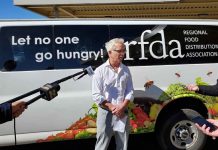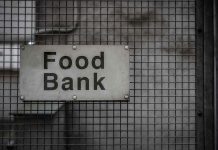INNSBRUCK, Austria – Food Banks Canada’s annual report paints a discouraging picture: more Canadians visited food banks this year than last year.
The newly-released report says that in the snapshot month this year, March, 852,137 people visited a food bank, up 1.3 per cent from last year. While this year’s number is lower than the 10-year high figure of 2013, when 872,379 Canadians were recorded using a food bank monthly, the report’s numbers indicate significant, troubling shifts in food bank use in the last 12 months.
About 80,000 Canadians used a food bank for support for the first time this year, on average, each month. And the number of children who are fed by food banks is astounding. Almost 36 per cent of food bank users are children – 305,000 of them.
The economy has negatively affected many Canadian families this year. This is particularly true in Alberta, where the number of food bank users increased by more than 23 per cent in the snapshot month. The severe and abrupt decline of the oil sector has hurt families and individuals. Three-quarters of the province’s food banks reported increased demand; nationally, 54 per cent of food banks reported increased applications.
The report also notes that 7 per cent of food bank users own their homes. This suggests that many seniors have experienced swift financial changes and have been forced to turn to food banks.
There is some good news in the report. Demand at food banks in Saskatchewan has remained flat since last year, while Ontario, Prince Edward Island, New Brunswick, and Newfoundland and Labrador saw the number of regular visitors decrease.
The report is a powerful reminder that food insecurity in Canada should be an open issue. Food insecurity, for most of us, is inherently an issue of private suffering. But the report shows the depth of the problem in Canada and that public awareness is critical to helping those in need.
For years, governments seemed to pretend food banks didn’t exist – they symbolized how social programs had let many Canadians down. It was hoped that food banks were a short-term solution to the challenge of domestic food insecurity. But the reality is that food insecurity in the industrialized world is an intricate and enduring problem. An acceptance of food banks’ economic role is gaining traction. Efforts are now focused on making food banks more efficient, rather than eliminating them.
Food banks are evolving, moving from warehouses for food surpluses to providing food distribution and processing. In Europe, some food banks now operate as not-for-profit social franchises. Food banks are very much part of our communities.
Publicly-funded job centres in some countries now openly refer individuals to food banks, and we may see this in Canada soon. Food banks could serve a dual role – as food distributors and information nodes.
Whether the government is there to help families in need or not, food banks will remain. No government can get it right all the time. Food banks cover the cracks in an imperfect social benefits system, responding effectively to market needs. Every food bank differs, based on space, the number of clients served and the ingenuity of the people who manage them. No government programs can replicate what agile food banks do on a daily basis.
Where Canada’s government can be most effective is in the North, where residents are highly vulnerable to higher food prices. The new Liberal government has promised $40 million over four years to support a program called Nutrition North, which is designed to keep food prices lower. In the past, funds have been put into the distribution system. But a more efficient approach would be to equally disburse funds to food consumers.
Certainly we ought to find ways to make sure food banks are needed less in the future. But food banks are miracles of the human spirit, allowing us to help our peers in desperate times. That is a wonderful legacy.
Dr. Sylvain Charlebois is a professor at the Food Institute at the University of Guelph. He is currently on leave at the University of Innsbruck in Austria. Follow Sylvain via RSS
© 2015 Distributed by Troy Media







